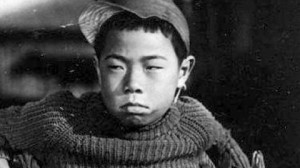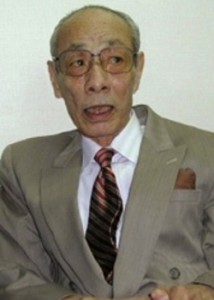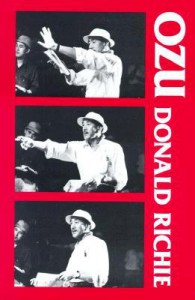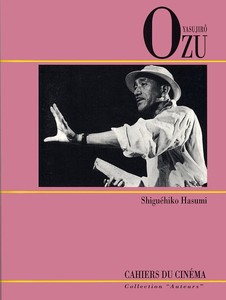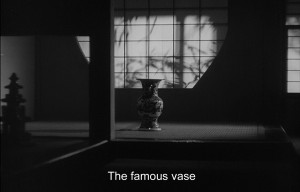Written for the Japanese literary magazine Eureka‘s special issue devoted to Shigehiko Hasumi in early 2017. — J.R.
14 December 2016
Dear Shigehiko,
I’m indebted to you for a good many things, including my very first visit to Japan. This was eighteen years ago, in December 1998, to participate in a panel about Ozu that you organized for Shochiko in Tokyo, significantly titled “Yasujiro Ozu in the World,” along with Jean Douchet, Hou Hsiao-hsien, Thierry Jousse, and Tien-wen Chu. Undoubtedly the most luminous moment of that event for me was being approached in the lobby immediately afterwards by an elderly gentleman who spoke in Japanese to Hou and myself, shook our hands, and then walked away — a puzzling encounter that immediately (and appropriately) became explained to me via mime, as soon as Hou imitated for me the signature comic gesture of Tomio “Tokkankozo” Aoki, the younger son in I Was Born, But… — thus identifying the child actor discovered by Ozu who went on to enjoy a screen career that would eventually last seventy-five years, encompassing even Suzuki’s Pistol Opera. All of which made up for the disturbing fact that apparently none of the film students I spoke with at Tokyo University had seen any of Ozu’s silent films, even though all of the surviving ones were available on VHS.
My second and so far only other visit to Japan — one year later, thanks to receiving a Japan Foundation grant, during which I recorded an extended conversation between us about Howard Hawks and Yasuzo Masumura for a collection entitled Movie Mutations — grew directly out of the first. (As I recall, these were your second and third years as Tokyo University’s president.) I still treasure the beautiful Japanese book by and about Masumura that you gave me on that visit.
I’ve often wondered how you came to invite me to be on that Ozu panel and, to my further delight, subsequently included a link to my contribution, entitled “Is Ozu Slow?”, on your own web site. Prior to my first visit to Japan, I wrote about Ozu twice — once in my “Paris Journal” for Film Comment (Summer 1972), which included a report of the first Ozu retrospective ever held at the Cinémathèque Française, and then in a lengthy article in Sight and Sound three years later entitled “Richie’s Ozu: Our Prehistoric Present” — a violent attack on the first book-length study of Ozu in English that I currently regret enough to exclude from my own fairly comprehensive web site. [2020 note: over two years later, I belatedly posted this article, in spite of some continuing misgivings about it.]
When I wrote this text, I hadn’t yet met Donald Richie (1924-2013), who became a friend when I returned to Japan in December 1999, after he graciously accepted my apology for having written this article. Although my objections to his critical approach to Ozu remained — and remain to this day — there is also an unbridgeable difference between Richie’s role as an American intermediary and guide to Japanese culture and your own role as a Francophile Japanese critic whose book on Ozu I mainly know from its 1998 French translation. And indeed, there’s an irreconcilable difference between Richie’s assertion that Ozu is the “most Japanese” of all Japanese filmmakers and your own suggestion, based on Ozu’s reverence for Hollywood cinema, that he may in fact be the “least Japanese”. Yet it’s precisely in this difference that I find your book on Ozu so illuminating: the exemplary aim to liberate Ozu from the aura of exoticism brought by Western viewers, many of whom appear to want to use his cinema as a tool for discovering the otherness of Japanese culture. More generally, the challenges that you offer to such Western aficionados of Ozu as Richie, Paul Schrader, David Bordwell, and Kristin Thompson, all of whom seem to value his work for its deviations from Hollywood studio practices, remind us that Ozu was in fact interested in emulating many of those practices, at least as he understood them. In much the same fashion, William Faulkner was acutely conscious of stealing John Keats’ image of the Grecian urn on the opening pages of his great novel Light in August and apparently not so interested in his emulation of cinema in his use of the present tense on those same pages; and Dizzy Gillespie, by his own account, developed his own style by trying and failing to imitate Roy Eldridge, somewhat as Jean-Luc Godard in A bout de souffle presumably forged his own version of modernism by trying and failing to imitate Scarface.
In retrospect, I suspect that what led me to attack Richie’s book on Ozu so vehemently was what I took to be a position promoting a sense of cleavage between the formal beauty of his films and their thematic and emotional meanings — a cleavage that your own book on Ozu fails to recognize or honor, even while you clarify some of the cleavages that can exist between what Western viewers identify as a shot of a vase in Late Spring and what Japanese viewers perceive as a cluster of visual details. Had I been able to read your own book on Ozu in the mid-1970s instead of in 1998, when it appeared in French translation (after having been published in Japanese in 1983), my attack on Richie’s book would have been unnecessary. (Incidentally, it’s worth noting that it included, as a positive counter-example to Richie’s approach, an extract on Ozu from Noël Burch’s still-unpublished To the Distant Observer that would subsequently be deleted from his manuscript, and which consequently survives only in my article.
I alluded indirectly to my objection to Richie’s position towards Ozu in my presentation on your Ozu panel, as follows, in my discussion of I Was Born, But…: “During the home movie projection which marks the critical turning point in the film from comedy to tragedy, and shortly before the clowning of the father in front of his boss appears in one of the home movies, the father’s two little boys start having a debate about the zebra they see on the screen — does it have black stripes on white, or white stripes on black? — creating a disturbance that momentarily halts the screening. In comparable fashion, a spurious, distracting, and no less innocent debate has been persisting about Ozu for years: is he a realist or a formalist? What seems lamentable about this debate is that it fails to perceive that cinematic forms and social forms are not alternatives in the world of Ozu but opposite sides of the same coin, so that it should be impossible to speak about one without speaking about the other. I regard this fact as the linchpin of my argument, and I hope that the remainder of my discussion essay will bear this out.”
For me, the most important sentence in your book, at least from my Western perspective, reads as follows: “Ozu’s talent lies in choosing an image that can function poetically at a particular moment by being assimilated into the film, not by affixing to the film the image of an object that is considered poetic in a domain outside the film.” This is quite consistent with your critical approaches towards Costa, Erice, Ford, Hawks, Naruse, and Suzuki — to cite only those in English or French that I have been able to read, which I also find both illuminating and original. But it is the commonsensical lucidity of your arguments about Ozu that have taught me the most — not only about film poetics but also about cultural differences, and, above all, how we perceive (and sometimes fail to perceive) those poetics and differences.
All my best and warmest wishes,
Jonathan


